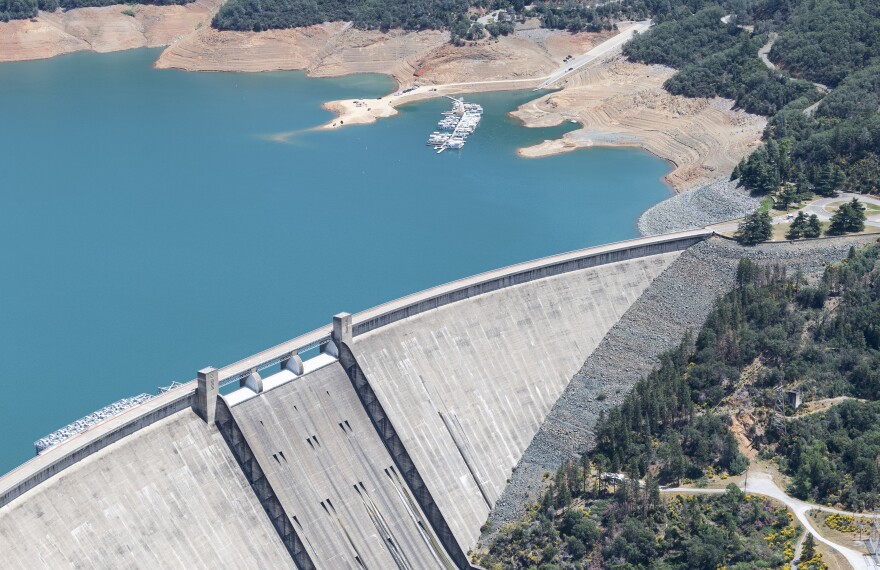Truth matters. Community matters. Your support makes both possible. LAist is one of the few places where news remains independent and free from political and corporate influence. Stand up for truth and for LAist. Make your year-end tax-deductible gift now.
As California Heads Toward Another Year Of Drought, Experts Predict Stricter Rules And Hope For Better Solutions

State officials say our reservoirs continue to be far below average levels for this time of year, and they’re expecting another drought year in 2023.
Drought managers say the reason is largely a sign of the worsening effects of human-driven global heating, as well as the likelihood of a third year of La Niña, a natural weather phenomenon that usually means less than average rainfall (new research shows global heating could make La Niña weather more common).
According to the California Department of Water Resources, the current drought has been the driest three-year-period in more than 100 years.
“We have definitely been seeing more droughts and increasing impacts this century as compared to the last century, reflecting our transition to a warmer and drier climate,” Jeanine Jones, drought manager for the California Department of Water Resources, said at a press briefing on Monday.
October marks the start of the new water year, the official 12-month timeframe used by water managers to assess supplies and build hydrological records.
State officials predict global heating will cause California to lose 10% of its water supply by 2040.
The Impact
Agriculture uses the bulk of the water from systems managed by the state and federal governments — about 80%. The rest goes to cities.
Jones said farmers in the Central Valley received no water this year, digging into groundwater supplies instead or leaving fields to fallow.
Allocations from the State Water Project, which pipes water from Northern California to farmlands and cities in the Southland, were cut to just 5%, a reason why six million Southern Californians are currently under restrictions.
The current drought is even drier and hotter than the last record-breaking drought, which ran 2012 to 2016 and prompted then-Governor Jerry Brown to mandate a statewide 25% reduction in water use.
Last year, Gov. Gavin Newsom called for a voluntary 15% statewide reduction in water use, but hasn’t set a mandate like his predecessor. The reason, said Jones, is many water agencies decried Brown’s 25% mandate, saying there is no one-size-fits-all approach to water conservation in California, where water supplies can vary dramatically.
For example, the northern part of Orange County primarily gets its water from one of the largest coastal underground aquifers in the region. The city of Los Angeles, on the other hand, imports most of its water from northern California and the Colorado River.
There are some statewide emergency water conservation regulations temporarily in place due to the drought, including a ban on using drinkable water to irrigate decorative or non-functional grass at commercial, industrial, and institutional properties, including homeowners’ associations.
Last winter was the driest January-to-March period on record, according to state officials, prompting the Metropolitan Water District of Southern California, which supplies water to some 19 million people across the Southland, to declare a water shortage emergency for the first time since it was established in 1928.
That triggered the outdoor watering rules that six million southern Californians are currently under. However, Angelenos have saved record amounts of water since mandatory water restrictions started in June, but another dry year could lead to stricter measures.
Looking Towards The Future
Jones said efforts to recycle more water, capture stormwater and continue conservation during wet years are essential strategies in a drier and hotter reality.
State Climatologist Michael Anderson said agencies from the federal to local level also need to change their approach to water management and improve communication throughout the year, especially as climate change makes weather more volatile.
“It’s hard for us to find an average anymore,” Anderson said. “If you look at the year-to-year variability, it seems to be increasing and we find ourselves further away from average.”
He said state and federal water managers often set their communication around the traditional start and end of the wet season, but that coordination will increasingly need to happen throughout the year “due to the fact that conditions are changing within the water year.”
Jones said there also needs to be a bigger investment in infrastructure, especially as those wet years become less predictable and more extreme when they do come.
“We need to keep in mind that a lot of our water infrastructure was designed on the basis of the hydrology of the mid–20th century,” she said. “And we haven't invested in a lot of that major infrastructure since it was built."
"As we look at a warming climate," Jones continued, "not only do individual communities need to do things such as water recycling projects or conservation or desalination or whatever, but we have to think about adapting some of our backbone infrastructure so that we can take these high flows when they become available … and make better use of them."
Governor Newsom recently released a plan on dealing with the impacts of drought, though many environmentalists criticized it for having little focus on the agriculture industry. You can read more about it here.








